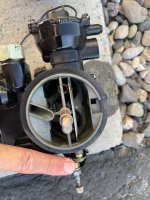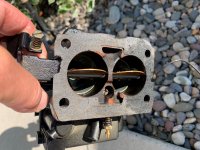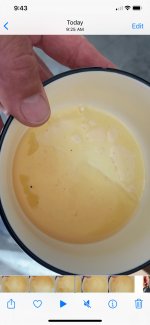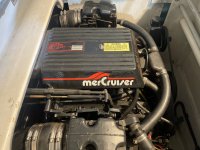I promised a response so here goes. The short story is that I have it back together and running. It appears that everything is fine and that no water is entering in where it shouldn't be to get in the oil. Thanks again for the input.
Now for the rest of the story. This will get a little long. And let the circus music begin...
As I was cleaning up the intake manifold it became quite clear that the water came in thru the carb. There was a lot of rust under the carb so I took a lot of time to scrape and blow it out. Then on to the heads that were still on the block in the boat. As carefully as I could I scraped them clean with a towel tucked neatly over the top of the block to prevent anything from dropping down inside. When I got that finished and vacuumed up I just stretched the cockpit cover over it and snapped it over the back of the boat to protect it from the elements in case of inclimate weather. It hasn't rained all summer long since probably June and you can imagine where this is going.
We had a spectacular lightning storm that night and then came the rain. But everything was fine because the boat cover was on...right? As the storm went on I thought that I should maybe just check on it, only to find a large pool of water that had collected on the cover directly over the engine. Sunbrella material holds water doesn't it? Probably if I didn't have a seam running down the middle of it. I peaked under the edge to see if any water was leaking thru. It wasn't dripping....it was gushing exactly into the top of the engine....right thru the towel. Man what a pain! I took care of the pool of water to stop it and the storm quit. I went to bed to deal with it in the morning.
I woke up and headed out there, figuring that I had another quart of water in the fresh oil that I had in there. Pulling the dipstick showed that the oil was several inches above where it should be. I inserted my pump tube and started pumping out the water. I still had a half full container of the the old oil/water mixture from the last time so I pumped that the rest of the way full of straight water. The started on another gallon jug and filled that to the brim...again, nothing but water. I had close to 2 gallons of water this time!
This was the day that I had the new gasket and everything else that I needed so I got the water out, cleaned up everything and reinstalled the intake and everything else, this time making sure it was covered up well in case it rained again. The RTV needed a little time to cure and I had church and stuff on Sunday so Monday I was able to get it running again...thank goodness!
During the saga I had time to develop what in my mind is the only plausible way that the water could have made it in there over the winter while it was shrink-wrapped. When I winterized it last year, I recall that I didn't close off the engine cover all the way. There was a few inches directly above the middle part of the engine that was exposed. No big deal....it was shrink-wrapped! I always cut vent holes in the front and back so it can breath. Well, apparently I made them too big because our local feral cat saw it, and as you might imagine, decided to use my boat for its house for the winter and in forcing it's way thru the hole, it also tore off the cover to the vent hole which would allow some rain and snow to get thru the hole...which just happened to be positioned....yep, you guessed it....right over the engine area. And my plastic engine cover that fits over the air cleaner has a couple decent cracks in it so I can definitely see how water could pool on the cover and funnel right thru the cracks and into the carb.
Needless to say I learned a lot from the experience. It appears that everything is fine with the boat. I haven't been able to get it on the water yet but did run it quite a bit yesterday.
Is anyone on this forum good at feral cat hunting?

























